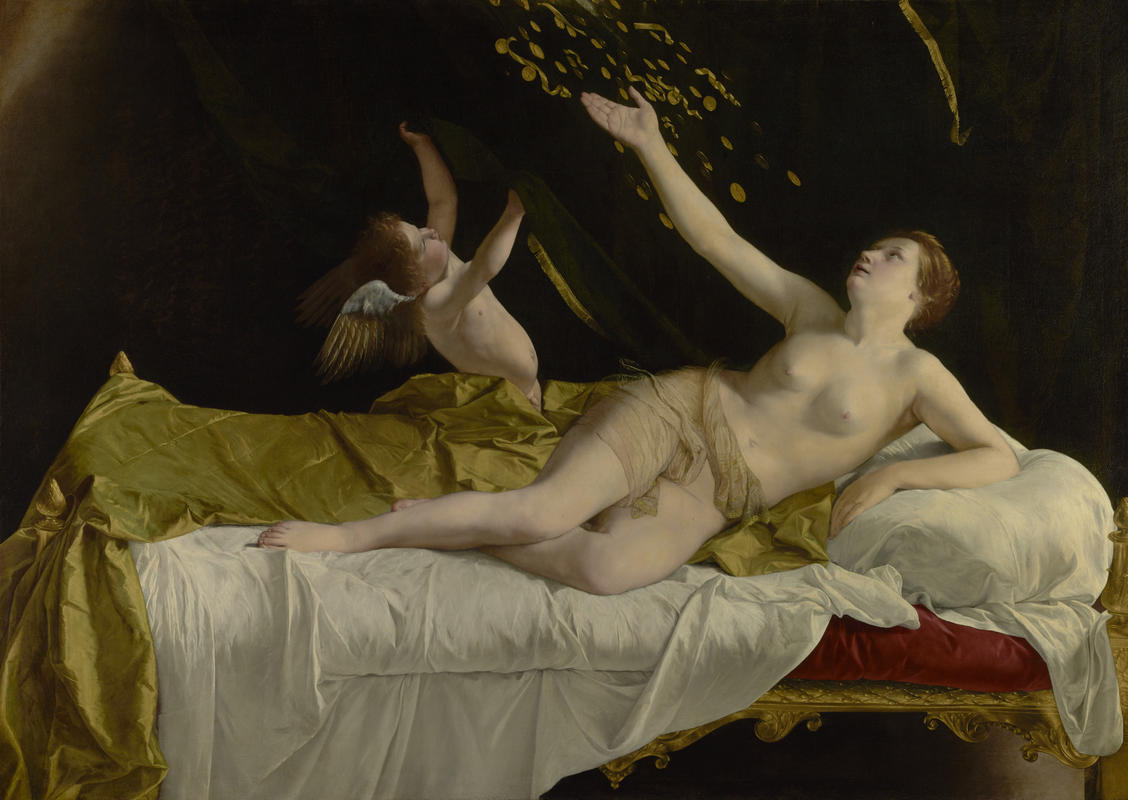More about Danaë and the Shower of Gold
- All
- Info
- Shop

Contributor
If you’re like me, you may stand in front of Danaë and the Shower of Gold by Orazio Gentileschi, and ask yourself, ‘Why, dear god, are gold coins being flung at this woman’s face?’
To understand, you must know the Greek story of Danaë from Ovid’s "Metamorphosis." King Arcisius of Argos locked his beautiful virgin daughter, Danaë, in a bronze chamber for all eternity after learning from an oracle that one day she would have a son that would ultimately become a king slayer. Zeus (Greek)/Jupiter (Roman), a god that likes a good challenge, decided he must have the beautiful Danaë. Being he’s a god, he transformed himself into golden "rain," flooding Danaë’s chamber, impregnating her. Danaë’s son, Perseus, went on to kill Medusa—AND his grandfather, King Arcisius. The story over time evolved from a golden rain shower to a gold shower of coins. And Danaë became an immoral seductress, because, come on… she took gold coins for sex!
In Gentileschi’s painting, Danaë willingly receives the “golden shower” directed at her face rather than at her modestly covered nether parts, probably thinking, “I’ll get hit in the face this one time if it means I can get out of this place.” Hmmm… just like a porn star working to pay off her law school loans. Gentileschi painted this—a pagan story—and two other grand paintings: Lot and His Daughters from the Old Testament, and Penitent Magdalen from the New Testament, as a loosely themed triptych for the Genovese, Giovanni Antonio Sauli, in the 1620s. Art historians have been speculating about the theme. Maybe it’s about women and their relationship with God—the ravished, the ravishers, the redeemed. But probably, the theme was just a guise for Sauli to own pretty pictures of sexy women. The painting stayed within the Sauli family until the 1970s. Since then, it’s been a slippery minx.
In 1977, London dealer, T.P. Grange, shipped the life-size painting to Norton Simon in Los Angeles who expressed interest in the masterpiece. And waited for a Simon’s response. And waited… Finally, Simon sent the painting back to London to have it inspected. When it was discovered the painting was indeed one of the three painted for Sauli, Grange gave Simon a deadline of midnight, October 29 to take it or leave it. And then Grange waited… and waited.
In the meantime, back in New York City, interested American collector Richard Feigen flew to London and waited Simon out. The midnight deadline came and went, and Feigen snatched it up. But lo and behold, a telegram arrived from Simon at 5:41 Pacific time, but 1:14 AM London time. Oops. Too late. Simon sued. After a year, both Grange and Feigen gave Simon $100,000 each for damages, but Feigen kept the painting. And a good thing he did! Flash forward to 2012. The painting was on loan to the Metropolitan Museum of Art, who hoped upon hope, that Feigen would just give the painting to the Met. Imagine the Met’s disappointment when they learned the painting was the highlight of Sotheby’s Master Painting Evening Sale slated for January 2016 and priced at a cool $25-35 million. “Hey! But we called this painting an ‘extraordinary tour de force!’ It’s right here on the label! Hanging on our wall!”
Alas, the painting wasn’t in the Met’s budget—but not for the deep pockets of the Getty Museum. The painting was snapped up for $30.5 million and installed at the Getty right next to one of its two sister paintings, Lot and His Daughters, (acquired in 1998) which as a story, is another whole crazy ball of wax.
Sources
- Christiansen, Keith, and Mann, Judith Walker. Orazio and Artemisia Gentileschi. New York: Metropolitan Museum of Art, 2001.
- J. Paul Getty Museum. “Danae and the Shower of Gold.” Los Angeles: Getty.edu, 2016.
- J. Paul Getty Museum. “Orazio Gentileschi in Genoa: Paintings for the Palazzo Sauli.” Los Angeles: Getty.ed, 2002.
- Knight, Christopher. “Getty Purchases Gentileschi’s ‘Danae’ now owns 2 or 3 paintings in set.” LA Times, June 30, 2016.
- Moore, Susan. “Old Masters: trophies of a Golden Age.” Financial Times, November 15, 2015.
- Muchnic, Suzanne. Odd Man In: Norton Simon and the Pursuit of Culture. California: University of California Press, 1998.
Featured Content
Here is what Wikipedia says about Danaë (Orazio Gentileschi)

Danaë is a circa 1623 oil on canvas painting by the Italian artist Orazio Gentileschi. It is an example of an Italian Baroque painting and is now in the collection of the J. Paul Getty Museum, in Los Angeles.
History and description
The painting was commissioned in 1621 by Giovanni Antonio Sauli who had invited Gentileschi to Genoa. Gentileschi painted a number of works for Sauli besides the Danäe, including a Penitent Magdalen and a Lot and his Daughters. The painting draws together the Caravaggesque naturalism that influenced Gentileschi's earlier work with the Tuscan lyricism he later developed.

The subject of the painting is the ancient Greek myth of Danaë, which tells of how Zeus, king of the gods, visited Danaë in a shower of gold, from which union Perseus was born. The myth is regarded as a forerunner of the Christian belief in the Annunciation, the divine conception of Christ.
Orazio's daughter Artemisia Gentileschi had portrayed Danaë earlier.
The painting was auctioned at Sotheby's New York on 28 January 2016. It was the most important Baroque painting to be offered for sale in decades, and purchased for US$30,500,000 by the Getty. It is to be hung alongside Gentileschi's Lot and his Daughters.
The arrival of Zeus is foretold by Eros, who pulls aside a dark green curtain to let the golden rain fall. Gentileschi manages to blend the movement and dynamism of gold coins and falling ribbons with the serenity of Danae's sculptural physicality and classic charm. Danae is lying on her bed waiting for her, on a white mattress over which lies a golden blanket. Although the figure is quite sensual (the woman is covered only by a transparent veil in the pubic area), Orazio Gentileschi painted her with such grace and moderation as not to make the scene descend into the vulgar: Danae remains a chaste figure who accepts her ineluctable fate. It is a completely different Danae from the consenting one painted by Titian, today in the Capodimonte museum in Naples, which Orazio may have seen in Rome, when it was exhibited in Palazzo Farnese. The painting knows how to combine the Caravaggesque naturalism that influenced Gentileschi's previous works with the Tuscan lyricism that he later developed.
Check out the full Wikipedia article about Danaë (Orazio Gentileschi)













